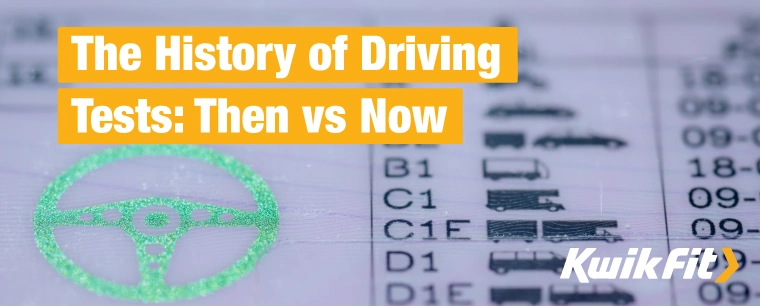The History of Driving Tests: Then vs Now
Jack Dreyer | Monday 13th May 2024 8:00am

Can you imagine a world where driving tests don’t exist? How different would our roads look today? These are inconceivable questions when we think about how important road safety education is.
There are over 30 million cars on the road in the UK today, but there was a time when this was as little as a couple of million. So, it’s no surprise that driving tests emerged and have evolved over the years.
In this blog, we will explore the history of driving tests, how they looked when they were first introduced, and how their format has changed over the years.
When were driving tests first introduced?
It may be hard to believe but driving tests were not a requirement when vehicles were first manufactured and introduced in the UK. As long as the driver had a licence and their vehicle was registered and licensed, they were able to drive!
However, it became increasingly evident that greater measures were required for the health and safety of drivers. Despite there being less cars on the road, 7,000 deaths from road accidents were recorded in 1931. In that same year, the first edition of the Highway Code was released.
In 1935, driving tests were introduced by the Road Traffic Act 1934 and became a compulsory part of the process of becoming a driver.
The format of early driving tests
As you can imagine, when driving tests first came on the scene, their format was simplistic. Drivers were required to execute a reversing manoeuvre, a three-point turn, a hill start, and an emergency stop. However, despite only covering a few manoeuvres, just 63% of candidates actually passed their test in the first year.
Over the years, driving tests evolved and became harder for drivers to pass. As well as completing the practical element, potential drivers were expected to complete a written test and road signs test, helping to ensure participants felt confident and competent on the road.
Today, the driving test format looks completely different.
What does a driving test look like today?
As of May 2024, the Government website states there are five parts to the driving test:
1. An eyesight test
This ensures the learner can read a number plate from a distance of 20 or 20.5 metres depending on whether the number plate is a new-style or old-style one. If the participant can’t read the number plate, they will receive an automatic fail and the test is ended.
2. ‘Show me, tell me’ questions
The ‘show me, tell me’ element takes the form of two questions - the ‘tell me’ question is asked before any driving begins and the ‘show me’ question is asked during the drive. Typical questions that may be asked include:
- ‘Tell me how you’d check that the brakes are working before starting a journey?’
- ‘When it’s safe to do so, can you show me how you wash or clean the rear windscreen?’
3. General driving ability
This section of the test will require learners to drive in different road conditions, pull over to the side of the road and, potentially, carry out an emergency stop.
4. Reversing your vehicle
This will include either a parallel park, parking into a car park space, or pulling up on the right-hand side of the road and reversing for two car lengths.
5. Independent driving
This section involves driving for approximately 20 minutes by following either the directions of a sat nav or traffic signs.
All of these parts are included in the test to help the examiner determine if you are a competent driver. If the participant makes a mistake, it could be considered a minor or major fault depending on the severity of the situation. A driver can make no more than 15 driving faults (minors) and still pass their test; however, a serious or dangerous fault (major) is an automatic fail.
Challenges for learner drivers
It’s clear that driving tests have evolved significantly since their introduction in the 1930s. These changes have made it more challenging for learners to pass their driving test, with only 48.4% of participants passing their driving test in the year ending March 2023. However, this statistic could arguably be seen as a positive as road accident collision rates are steadily declining in comparison to previous years.
Keeping you safe on the road
Driving tests are in place for a reason, not only to ensure drivers feel competent and knowledgeable on what they need to do on the road, but to keep themselves and others safe, too.
At Kwik Fit, we place driver safety at the forefront of all our services. Whether you require a vehicle servicing or MOT, new tyres or a free brake check - we’ve got you covered. Get in touch with our team of experts today at your local centre.
And, don’t forget to keep up-to-date with driving best practices and road safety news on our blog.
Any facts, figures and prices shown in our blog articles are correct at time of publication.
Featured Articles
Is it Illegal to Drive With One Headlight?
Saturday 19th July 2025
Wondering if it’s illegal to drive with one headlight? Learn about the safety risks and penalties of illegal blown bulbs and why you should fix them promptly.
Air Con in EVs & Hybrids: Experts Answer Your Questions
Monday 30th June 2025
Does air con drain EV batteries? Can you use the air con while charging an electric car? Find out the answers to these questions & more from Kwik Fit’s experts.
Why Is Your Car Making a Noise? Fixes & Tips
Friday 13th June 2025
When your car starts making unexpected noises, it can certainly be quite disconcerting; it may be nothing to worry about, but here’s what you need to know.









